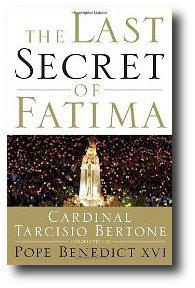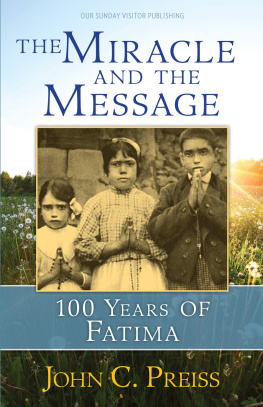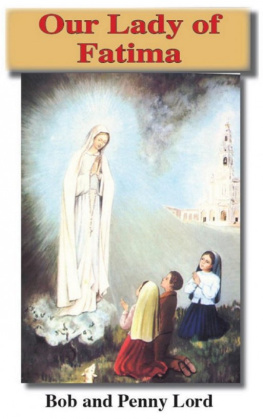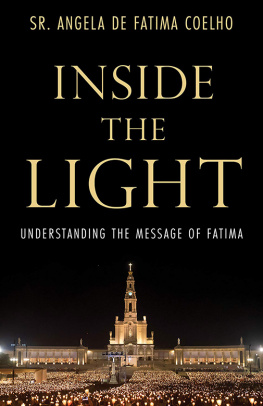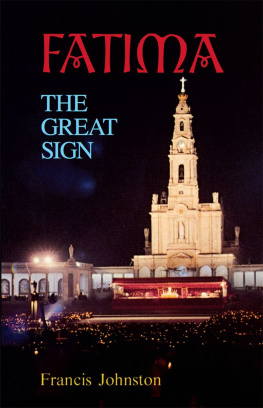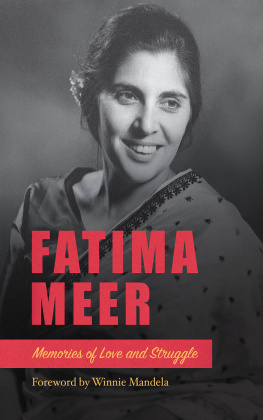CARDINAL TARCISIO BERTONE
THE LASTSECRET
OF FATIMA
My Conversations with Sister Lucia

WITH GIUSEPPE DE CARLI
ForewordBy POPE BENEDICT XVI
To John Paul II, the Pope of Fatima
To Benedict XVI, the Pope of the Black Madonna of Alttting
CONTENTS
FOREWORD BY POPE BENEDICT XVI
TO His Eminence Cardinal Tarcisio Bertone,Secretary of State
Venerable Brother, you have entrusted so many memories to the pages of your book, L'ultima veggente di Fatima, in order that they may not be just a precious baggage of personal emotions but might be consigned to the collective memory as meaningful traces of the Church's age-old history, since they deal with events which marked her in the last part of the twentieth century.In fact, we both lived the chapter that addresses the publication of the third part of the Secret of Fatima in that memorable time of the Great Jubilee of the Year 2000: I, in my capacity as prefect of the Congregation for the Doctrine of the Faith, and you, as secretary of the same dicastery.John Paul II, the great pontiff who preceded me, who was a font of prophetic inspirations and was personally convinced that it was "the motherly hand" of the Virgin who had diverted the bullet that might have killed him, realized that the time had come to dispel the air of mystery that shrouded the last part of the secret that the Virgin has entrusted to the three little shepherd children of Fatima. The Congregation for the Doctrine of the Faith, which preserved the precious document written by Sr. Lucia, was made responsible for doing so.It was time for illumination, not only so that the message could be known by all, but also so that the truth could be revealed amid the confused apocalyptic interpretations and speculation that were circulating in the Church, disturbing the faithful rather than inviting them to prayer and penance.Nevertheless, on the other hand, it was possible to see around the impressive Shrine the comforting development of Marian piety. This authentic source of Christian life, which had sprung up in Fatima and in every part of the world where devotion to the Virgin under the influence of the apparitions at Fatima was deeply rooted in the popular faith, was an invitation to men and women to consecrate themselves to the Immaculate Heart of Mary.The conversations between the seer, the last survivor of the three little shepherds, and you as the bishop sent by the pope, were not only an important ascertainment of the truthfulness of the events but also an opportunity for you to become acquainted with Sr. Lucia's transparent soul and her heartfelt intelligence typical of her femininity, which had been translated into a strong Christian faith. In addition, through the experiences of this humble sister, the role of the Virgin Mary shines forth, who gives Christians a motherly hand in the trials and tribulations of life.I myself wrote the "Theological Commentary" on the event, after having prayed intensely and meditated profoundly on the authentic words of the third part of the secret of Fatima contained in the pages written by Sr. Lucia. I was impressed by the comforting promise of the Virgin Most Holy, as a synthesis and a precious seal to it: "My Immaculate Heart will triumph."As I wrote: "The fiat of Mary, the word of her heart, has changed the history of the world, because it brought the Savior into the worldbecause, thanks to her Yes, God could become man in our world and remains so for all time."And further, "But since God himself took a human heart and has thus steered human freedom toward what is good, the freedom to choose evil no longer has the last word." The message of Fatima is a further proof of this.I invoke upon all who approach the testimony offered in this book, the protection of Our Blessed Lady of Fatima, and I impart my Apostolic Blessing to you, Your Eminence, and to Dr. Giuseppe De Carli, who shared with you the toil of drafting these memoirs.
From the Vatican, February 22, 2007
Pope Benedict XVI
A NOTE TO THE READER
The medieval Latin authors have given us a term that is helpful for understanding what this book attempts to accomplish: manuductio. The twelfth-century writer John of Salisbury uses the term in the sense of "safe conduct." In a more high-flown literary register, manuductio means "the act of leading by the hand." In this latter usage, the word refers to the author's method of guiding his reader toward understanding the meaning of the text.Our manuductio in this book is offered by Cardinal Tarcisio Bertone, who, while still secretary of the Congregation for the Doctrine of the Faith, was sent by Pope John Paul II to meet with Sister Lucia, the last visionary of Fatima, in her Coimbra convent. His assignment was to verify in conversation with her the genuineness and reliability of the text of the so-called Third Secret. The cardinal's errand was evidence of the eager interest of a pope who had become increasingly convinced that he was called to a mission of suffering. John Paul II interpreted the shooting as a sign. (After all, until the assassination attempt, everyone would have dismissed a prediction of a bullet in Saint Peter's Square as, well, some apocalyptic prophecy.) In an impromptu Angelus address delivered from the window of his study after an operation for a fractured femur, the pope gave powerful expression to his conviction that he had been called to suffer: "The pope had to suffer.... There is a higher Gospel, and it is the Gospel of suffering." Not only does the martyrdom of the twentieth-century Church coalesce, like coagulating blood, around the figure of John Paul II, but his personal story as pope took a supernatural turn precisely at a time when the secular Utopian ideologies were in full retreat.Cardinal Bertone's story is a work in progress, but it has the advantage of clarity. In contrast to the cloud of interpretations swirling around the message Our Lady delivered to the three shepherd children in 1917, his testimony in this book puts the final seal on the definitive version of the events. Expressions of doubt are notably absent from the account that follows. Rather, we find phrases such as "I am certain," "Lucia confirmed," and "her memory was absolutely accurate." Among the many mysteries unveiled in this book, we learn about the secret meetings between Cardinal Bertone and a nun who for decades had knocked mostly in vain at the door of the Vatican. Sometimes the shortest distance between two points is, well, an arabesque. Not this time, though; here it is a straight line that drives right into the heart of the issues. Cardinal Bertone's notes reveal to us the real Lucia, whom the cardinal describes as a persistent, stubborn, exuberant Carmelite nun. And through Lucia we are transported back to the Cova da Iria, where we become playmates of the three children whose lives were powerfully touched by the divine. Lucia is the leader of the group, the one who listens and explains. Similarly, it is Lucia who writes "despite the repugnance I feel, I will obey"; who reveals connections that can't be mere coincidences or literary inventions; whothrough the words of Cardinal Bertoneintroduces us to the "meta-story" of Fatima and sets aside once and for all the suspicions that the Fatima texts were doctored to hide the truth. With guides like these, we need have no anxiety about ending up lost in a "dark wood of error." On the contrary, we can be confident that our journey will lead us back, almost by magic, to the extraordinary, poetic atmosphere we encounter whenever the sacred invades a truly open mind with its superhuman presence.In the following pages, Cardinal Bertone shares with us his amazement over Lucia as a person. But he also invites us to join him in a deeper exploration of the greatness of the pontificate of John Paul II, the Pope of Fatima (and the pope of Dominus Iesus, just to be clear), the pope of "suffering and silence," as Benedict XVI described him. Fatima stands for the gift of a more mature faith, a faith that is not ashamed to give a broader scope to the emotions (which suggests one reason that Our Lady is the central personage in the majority of apparitions). Nevertheless, the following pages are not just about Fatima. They contain, for instance, a critical reflection on Medjugorje, and they revisit a significant portion of the pontificate of Benedict XVI (the conclave and the election, Benedict's role as "catechist to the world," the Regensburg lecture, his amazing trip to Turkey). Above all, though, this book is an effort to make the reader better acquainted with the heavenly messenger herself, that is, to understand the identity of Mary. We all know that fervor often mutates into gushing enthusiasm and that feeling can take the place of faith. It is tempting to exploit the extraordinary in order to glut the spiritual curiosity of the masses. Cardinal Bertone's calm and judicious mind offers us a powerful antidote to this temptation.Cardinal Bertone's story sheds a whole new light on the phenomenon of pilgrimages to Marian shrines. These pilgrimages are a form of prayer on the move. They begin with a radical decision: "Go from your country and your kindred and your father's house to the land that I will show you" (Gen. 12:1). In other words: Leave your home and set off, with an open heart, to a holy place where you can meet God. It is Abraham's response to this call, after his encounter with Yahweh, that marks the beginning of the whole history of salvation. The very fact of departing is already a victory over the inertia of habit; it is a break with all our customary mediocrity, a decision to set out on a path of forgotten demands and sacrifices. In a word: The cardinal's story helps us remember that the journey to the holy place is an expression of eschatological hope.
Next page
